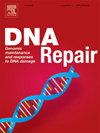Proofreading of mismatches within primer-template junctions by Escherichia coli DNA polymerase I in vitro and in vivo
IF 2.7
3区 生物学
Q2 GENETICS & HEREDITY
引用次数: 0
Abstract
Escherichia coli DNA polymerase I (Pol I) possesses a 3’ to 5’ proofreading function. Using a non-inhibitory in vitro proofreading assay and MALDI-TOF MS analysis, we demonstrated the Pol I proofreading function was effective at removal of mismatches within the primer-template junction. Mismatches of 1–4 nucleotides (nt) from the primer 3′ end could be completely or partially corrected, with no additional editing observed further upstream. A backward movement mechanism was proposed involving distributive backtracking of polymerase along the template to remove non-fully complemented primers in order for DNA synthesis to recover. Co-editing DNA substrates containing two mismatches, one at 1–4-nt of the primer 3’ end and the other outside of normal proofreading range, confirmed our distributive backtracking hypothesis. Additionally, a time course analysis revealed proofreading of internal mismatches was a non-processive reaction. To further confirm the validity of our proofreading model, we used in vivo, phagemid-derived nicked C-C substrates. Transformation results were consistent with the notion that mismatches located less than 4-nt upstream of the 3′ end could be successfully proofread. In vivo proofreading of double mismatches also supports our model of polymerase backtracking for internal mismatch editing.

大肠杆菌DNA聚合酶I在体外和体内对引物-模板连接错配的校正
大肠杆菌DNA聚合酶I (Pol I)具有3′~ 5′的校对功能。通过非抑制性体外校对实验和MALDI-TOF质谱分析,我们证明了Pol I校对功能在去除引物-模板连接处的不匹配方面是有效的。引物3 '端1-4个核苷酸(nt)的错配可以完全或部分纠正,上游没有观察到额外的编辑。提出了一种反向运动机制,涉及聚合酶沿着模板分布回溯,去除非完全互补的引物,以恢复DNA合成。共同编辑包含两个错配的DNA底物,一个在引物3 '端的1-4-nt,另一个在正常校对范围之外,证实了我们的分布回溯假设。此外,时间过程分析显示,校对内部错配是一种非过程性反应。为了进一步证实我们的校对模型的有效性,我们在体内使用了源自噬菌体的刻蚀C-C底物。转换结果与位于3 '端上游小于4-nt的错配可以成功校对的概念一致。体内双错配的校对也支持我们的内部错配编辑的聚合酶回溯模型。
本文章由计算机程序翻译,如有差异,请以英文原文为准。
求助全文
约1分钟内获得全文
求助全文
来源期刊

DNA Repair
生物-毒理学
CiteScore
7.60
自引率
5.30%
发文量
91
审稿时长
59 days
期刊介绍:
DNA Repair provides a forum for the comprehensive coverage of DNA repair and cellular responses to DNA damage. The journal publishes original observations on genetic, cellular, biochemical, structural and molecular aspects of DNA repair, mutagenesis, cell cycle regulation, apoptosis and other biological responses in cells exposed to genomic insult, as well as their relationship to human disease.
DNA Repair publishes full-length research articles, brief reports on research, and reviews. The journal welcomes articles describing databases, methods and new technologies supporting research on DNA repair and responses to DNA damage. Letters to the Editor, hot topics and classics in DNA repair, historical reflections, book reviews and meeting reports also will be considered for publication.
 求助内容:
求助内容: 应助结果提醒方式:
应助结果提醒方式:


